|
The "Lost Tombs" Revisited:
"Success Has a Thousand Fathers ..."
Part IV
So, where are we?
Remember, this all began (this time!) in an ancient southern Temple
... at a distant place called Abydos ... in Egypt.
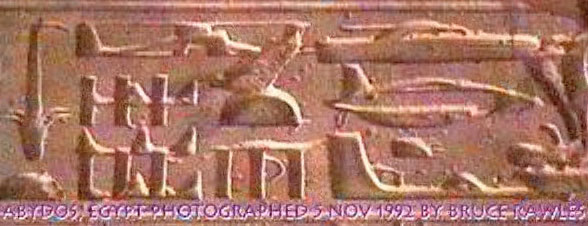
What, then, is "Abydos?"
The real question should be: what is the larger context of this
ancient, highly revered place where these "annoying Temple glyphs"
(above) were first discovered ("rediscovered?") by groups of recent
tourists visiting the magnificent 3300-year-old "Great Temple of Seti-I
..?" Abydos is located at the edge of the Western Desert,
inland from the Nile, about three hundred miles south of Cairo. It
is here to Abydos, long before Seti-I built his unique Temple, that
the oldest known religious pilgrimages -- millennia ago -- were
inexplicably begun, initially from all over Egypt ... but now
literally from all the world!
The earliest stated reason was to pay respects to "Khenty-Amentiu,"
the reigning deity of this remote "City of the Dead" [a name
meaning, incidentally, "First (or President!) of the Westerners,"
(i.e. the Dead -- identified as such because they were always buried
on the Western side of the Nile). The honorific
very early on, according to Egyptologists, became synonymous with "Osiris"
himself -- as "Osiris Khenty-Amentiu" -- ultimately, Ancient Egyptís
"íPresidentí and everlasting god ... of the Resurrected Dead"].
A practical reason for choosing Abydos as the remote location for
such a major necropolis, i.e. a "City of Osiris" (lying at the edge
of the desert, 22 miles south of the regionís major city on the
Nile, "Thinis") is still unclear; it is historical fact that ancient
royal tombs were never built on "virgin ground," but always near
some older cemetery, so the presence of pre-dynastic graves at Abydos could have influenced the decision. But other archaeologists
have pointed out that "there are plenty of pre-dynastic burials much
nearer to Thinis -- at Salmani, for example ..." so the mystery
remains.
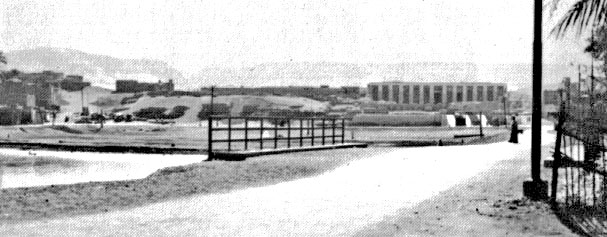
Photo Hanny El Zeini
Some have suggested that the answer may come from the mountains
lying directly to the West of Setiís glorious Temple (above)
-- which form the barrier between Abydos and the Great Western
Desert itself. In those mountains there is a pass (above) --
called "Pega-the-Gap"-- believed by the ancient, pre-dynastic
Egyptians to lead directly to the Kingdom of the Dead. As the
ancient royal tombs of Abydos lie closer to the mountains (and this
gap), its presence some argue may have inspired later kings to build
their "Houses of Eternity" here at Abydos literally, on the very
"edge of Forever ..."
At least, thatís how some Egyptologists attempt to "explain" the
initial, fundamental mystery surrounding Abydos ... itís sheer
existence where it is ...
 One remarkable "coincidence" about this explanation involves
"Pegasus" -- the well-known Grecian "flying horse" (right), which
got us initially involved with Abydos. For Pegasus (as
a white horse) is also, curiously, closely associated with the theme
of "death" in many other cultures, by way of "a steed who carries
souls to the Beyond ..." He is also strongly associated with water
-- having (in Greek mythology) ostensibly been born of it. (More on
this, below.) One remarkable "coincidence" about this explanation involves
"Pegasus" -- the well-known Grecian "flying horse" (right), which
got us initially involved with Abydos. For Pegasus (as
a white horse) is also, curiously, closely associated with the theme
of "death" in many other cultures, by way of "a steed who carries
souls to the Beyond ..." He is also strongly associated with water
-- having (in Greek mythology) ostensibly been born of it. (More on
this, below.)
Some scholars believe the Greek name "Pegasus" derives from the
ancient Egyptian word at Abydos for the very "Sacred Gap in the
Mountains - that leads directly to the Afterlife" (see box, below);
others believe the Greeks (who clearly "borrowed" heavily from the
earlier Egyptians, both in myths and terms) named their "flying
horse" after the Pega Spring ... the site of the oldest (c. 2000
B.C.) known shrine to Osiris, also found at Abydos.
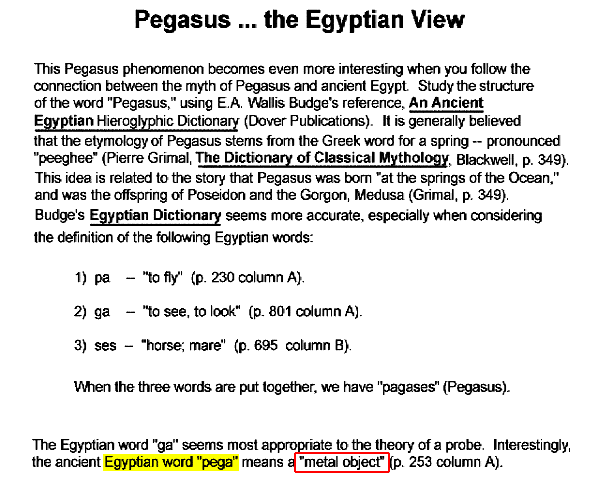
The linkage of the Greek "Pegasus" to these Egyptian roots, with one
possible interpretation being "a flying metal horse" (pega ses -- an
aircraft?!), which assists in "transport to the Afterlife - from Abydos" ... all leading, ultimately, to "Osiris" himself ... is
quite revealing. After all, what is depicted in terms of the
mysterious "glyphs" found inside Seti-Iís Temple at Abydos ... if
not, various means of "mechanical transport" ... i.e., simple
variations on "a metal horse?!"
"Abydos."
 It is extraordinary (in terms of our continuing examination of
a
potentially modern "Cult of Osiris," apparently still alive and well
after all these millennia -- and now lurking deep inside NASA ...
just examine the ill-concealed, official NASA "Pegasus" patch for
the ill-fated Apollo13 -- left) that our continuing search,
stretching from the planet Mars ... to Ancient Egypt ... then to
Arizona ... and through Washington itself ... should have ultimately
led us here -- to "Abydos." It is extraordinary (in terms of our continuing examination of
a
potentially modern "Cult of Osiris," apparently still alive and well
after all these millennia -- and now lurking deep inside NASA ...
just examine the ill-concealed, official NASA "Pegasus" patch for
the ill-fated Apollo13 -- left) that our continuing search,
stretching from the planet Mars ... to Ancient Egypt ... then to
Arizona ... and through Washington itself ... should have ultimately
led us here -- to "Abydos."
For, as it has been for thousands of years, it is "Abydos" which, it
turns out to be, is the literal heart and soul of all that was ...
and is ... connected to "Osiris" in all Egypt ... if not in all the
world.
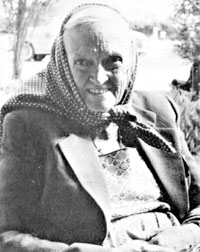 Or, so it certainly appeared to one well-known
modern chronicler of Abydos, the legendary "Omm Sety" (right). A remarkable woman in her
own right, a former British subject (originally christened Dorothy Eady), Omm SetyŪs Arabic name (it translates as "Mother of Seti")
was given as a result of her bearing an Egyptian child whom she
deliberately named after "Seti, the First". For Eady, from the age
of four, fervently believed she was in fact the reincarnation of a
former Egyptian priestess in service to Seti-I, part of his Great
Temple retinue who lived at Abydos during the Nineteenth Dynasty,
around 1300 B.C. Or, so it certainly appeared to one well-known
modern chronicler of Abydos, the legendary "Omm Sety" (right). A remarkable woman in her
own right, a former British subject (originally christened Dorothy Eady), Omm SetyŪs Arabic name (it translates as "Mother of Seti")
was given as a result of her bearing an Egyptian child whom she
deliberately named after "Seti, the First". For Eady, from the age
of four, fervently believed she was in fact the reincarnation of a
former Egyptian priestess in service to Seti-I, part of his Great
Temple retinue who lived at Abydos during the Nineteenth Dynasty,
around 1300 B.C.
In this lifetime, Eady left England for Egypt in 1933 at the age of
29; subsequently married an Egyptian, became "Omm Sety" and an
employee of the Egyptian Antiquities Service (editing field notes
and archaeological journals), and died at 77 -- after becoming an
acknowledged world-class expert on "Abydos and its Great Temple of
Seti-I ..."
Along the way, Omm Sety took up permanent residence in Abydos (in a
mud-brick peasant house near the "Great Temple") in 1956 -- and
remained there (as in her previous incarnation!) with her cats, a
goose, a donkey and an occasional snake, assisting archaeologists,
documentarians, visiting dignitaries, scientists and countless
tourists in getting to know "her" Temple, until her death in 1981.
After her departure, none other than Carl Sagan -- that perceived
paragon of "rationalist" thinking and hard scientific skepticism --
revealed an unexpected interest in Omm Sety and her "most
extraordinary" claims (if not in
Ancient Egypt, and in Abydos itself!), when he wrote the forward to
a book on her own controversial life -- "The Search for Omm Sety" --
in 1987.
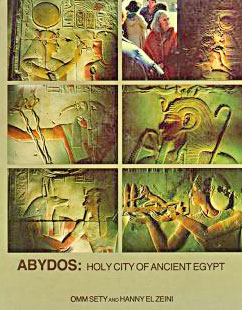 Her own written works included a last, co-authored volume on this
fabled "Osirian City of the Dead" (with photographs by Hanny El
Zeini), titled
Abydos: the Holy City of Ancient Egypt (LL Company,
Los Angeles, 1981). This lavishly illustrated volume (left)
describes in elegant words and stunning pictures the history and
archaeology of this remote but unique Egyptian center, the real
"Abydos" that Omm Sety truly loved ... Her own written works included a last, co-authored volume on this
fabled "Osirian City of the Dead" (with photographs by Hanny El
Zeini), titled
Abydos: the Holy City of Ancient Egypt (LL Company,
Los Angeles, 1981). This lavishly illustrated volume (left)
describes in elegant words and stunning pictures the history and
archaeology of this remote but unique Egyptian center, the real
"Abydos" that Omm Sety truly loved ...
It was in that Abydos where the inexplicable had once again
occurred: where a set of provocative, highly controversial and
illuminating "glyphs" had briefly come to light ... only to be
instantly dismissed. Glyphs potentially "connected" now (simply,
because of where they were -- in the ceiling of Setiís Great Temple)
to the deeper meaning of the already ancient, already profound,
already over-arching "mystery" of Abydos itself ... the venerable
center for the crucial "Death and Resurrection of Osiris" ...
Who was this "Osiris" -- and what, as "President of the Westerners"
was his obviously special relationship to this out-of-the-way place
... now known to us as "Abydos?"
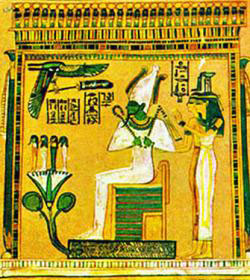 Omm Setyís Appendix to her book, "the Gods represented in the Temple
of Abydos," describes him thus: Omm Setyís Appendix to her book, "the Gods represented in the Temple
of Abydos," describes him thus:
"Osiris [üsar, in Egyptian], was one of the children of
Geb and Nut.
He became the King [Pharaoh] of Egypt and brought civilization to
his people who had previously been primitive, semi-nomadic hunters. Osiris taught them the arts of agriculture, gave them a settled
existence, and introduced the hieroglyphic script, which had been
invented by the God Thot. In all his work, Osiris was helped by his
sister-wife Isis, and the royal pair was greatly honored and beloved
by their subjects.
"But the God Set, their evil brother, was jealous of the esteem in
which Osiris was held, and he wished to have a share in the
government of Egypt. Knowing the evil nature of his brother Osiris
refused this request, and in anger, Set murdered him and seized the
throne.
"This original account has been repeatedly modified. According to
the earliest [written] version which occurs in the Pyramid Texts
(Vth Dynasty -- c. 2600 B.C.), Set murdered Osiris at Abydos and
left his body lying on the banks of the canal. Here it is found by
Isis and Nepthys [another sister] who with the help of Anubis [the
God of Mummification] embalmed and buried it.
"But with the rise in the importance of the
Cult of Osiris, this
simple and natural story was elaborated, and it was later said that
Set found the embalmed body of Osiris and tore it into fourteen
pieces which he scattered up and down the whole length of Egypt. On
hearing of this fresh outrage, Isis set out to search for the
scattered fragments of the body of Osiris, and wherever she found
one, she buried it and built a shrine to mark the spot. According to
this version of the story, the head was buried at Abydos.
"Later the
story of Osiris was still further elaborated, and the
classical author Plutarch tells that under the guise of friendship,
Set tricked Osiris into entering a beautiful decorated chest which
was then fastened shut and thrown into the Nile. The river carried
the chest out to sea, and it was finally washed up on the beach at
Byblos in Lebanon where overnight an acacia tree sprang up and
enclosed it. The King of Byblos had the tree cut down and made into
a pillar for his palace.
|
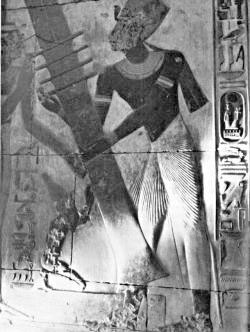
Photo Hanny El Zeini
|
"Meanwhile, Isis, by supernatural means,
learned the whereabouts of the body of her husband and, disguising
herself as a poor widow, obtained a post as nurse to the ailing,
only son of the King of Byblos. As in the ancient Greek story of
Demeter (Ceres), Isis cured the child by laying him each night in
the fire. The child recovered from his sickness and Isis claimed as
her reward the pillar, which contained the body of Osiris. To the
astonishment of the King and Queen of Byblos, Isis opened the pillar
and revealed the chest containing the body of the God with which she
returned to Egypt leaving the empty pillar to be preserved as a
sacred relic in the temple at Byblos. This element of the story is
probably based on the annual religious ceremony [held at Abydos --
left] of íSetting Up the Djed Pillar,í which symbolized the
resurrection of Osiris.
"Both early and late accounts tell how
Isis, fearing the wrath of
Set, fled to the marshes of the Delta where her son Horus was born
and reared. When he reached manhood, Isis inspired Horus to avenge
the murder of Osiris and claim the throne of Egypt as his rightful
inheritance. After many military and legal battles, Horus finally
vanquished Set and regained the throne of Egypt ruling in the high
traditions of Osiris and becoming the perfect type of pharaoh for
all future kings to imitate.
"Because of his virtuous life on earth,
Osiris was resurrected to
rule as King and Judge of the Dead in the Other World. In his great
Hall of Justice, the heart (the seat of the conscience) was weighed
in a balance against the ostrich feather of Maat [the goddess of
Truth -- right]. This element is also found in the early and late
versions of the story and is the earliest written evidence ever
known of the belief in manís responsibility for his actions on
earth, and shows the high ethical character of the Egyptian religion
attained at such an early stage in manís attempt to build his moral
and ethical principles [emphasis added] ..."
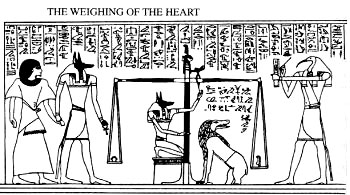
One of the central questions, still unanswered by any current
archaeology, is the obvious: was this "Osiris" a "real" pre-historic
pharaoh?; was there actually an "Isis," a "Set" or "Horus" in his
kingdom? And was he cruelly murdered as demanded by the "plot?"
Or, were these endlessly retold and reenacted myths, involving these
key "players," in fact, carefully "coded" allegories ... crafted by
the Egyptian priest-hood as a specific means of preserving -- yet,
at the same time, masking from "the profane" -- far deeper, ancient
truths ..?
Omm Sety herself details some of these "secret" ceremonies,
orchestrated across millennia for "the faithful" by the resident
priesthood at Abydos:
"... on the days of annual pilgrimage, which coincided with the
Great Feast of Osiris [from the 23rd to the 30th of the
month of Khiak, which corresponds to January of the modern calendar], the
[Abydos] necropolis became like an overcrowded city. Families [that]
had tombs there would be encamped in the courtyards. Early comers no
doubt found accommodation in the inns of the city, and the tardy,
for whom íthere was no room at the inn,í could camp out in the
temple courts or take shelter under the massive walls of the Temenos
where they would have to share space with vendors of ísouvenirs of
Abydosí (scarabs, small bronze figures of Osiris, amulets, etc ...).
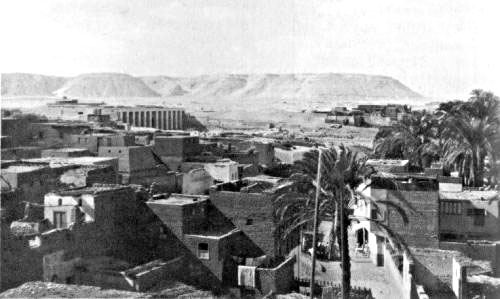
Photo: Hanny El Zeini
"Although [the play] had probably been in existence since very early
times, we now find proof and even details of the sacred Mystery Play
[titled by Egyptologists "The Great Procession of Abydos"] performed
here at this season. This play showed incidents in the life, death
and resurrection of Osiris. In this play the part of Osiris was
taken by a life-sized wooden statue of the God, adorned with gold
and semiprecious stones. Horus was traditionally played by the King
[Pharaoh] himself, although he sometimes delegated this honor to some
important official. The other gods were personified by the priests
and priestesses, and it was stipulated that women who played the
parts of Isis and Nepthys should be virgins ...
"Each episode of the play took place on a separate day and in a
special place. Some scenes, such as the murder of Osiris, took place
inside the Temple (above) with only the king and priesthood present.
The sacred boat of Osiris, called
Neshmet, was an important factor
in this play, and sailed from Thinis to Abydos bearing the statue of
Osiris and the sacred actors ...
"As we have said, the murder of Osiris was too sacred, too tragic
and harrowing for public presentation, and the next episode [in the
play] was the search for the body. This was enacted on the banks of
the canal [connecting Abydos to the Nile] where the original
incident was supposed to have occurred ..."
So, the ultimate "special meaning" of this remote place -- which
demonstrably became the holiest in all of Egypt for both pharaoh and
"commoner" alike -- was that here at Abydos is where "Osiris"
actually was murdered ... and lies buried (or, at least his head!)
... somewhere underneath its "sacred sands."
This major assertion -- reinforced repeatedly in annual reenactments
of Osirisí tragic death for literally thousands of years (if such a
circumstance is even
comprehensible by "Western" minds) -- was further reinforced in 1909
by the chance discovery at Abydos of a mysterious underground
"structure" ... which some believed could finally be Osirisí "Long
Lost Tomb" ... much older and far more provocative than even Setiís
splendiferous New Kingdom Temple:
Presupposing the whole issue, it was even called from the moment it
was found: the "Osirion" ... the Monument to Osiris.
Omm Sety wrote it up this way:
"This imposing subterranean building (right) is one of the great
puzzles of Egyptian Archaeology. No one really knows who built it or
for what purpose, and so far as is known, there is not another one
like it in the whole of
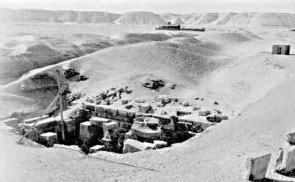 Egypt. Curiously enough, certain elements of
its architecture closely resemble the íGates of the Suní in
Peru,
high up in the Andes Mountains ... Egypt. Curiously enough, certain elements of
its architecture closely resemble the íGates of the Suní in
Peru,
high up in the Andes Mountains ...
"... it was not until the early 1920ís that the whole building was
excavated and an account was published by Professor Henri Frankfort.
Because he found the name of Sety I in the decoration of the ceiling
of one of the rooms, he attributed the building to him and called it
the Cenotaph of Sety I ... This is only one of many restorations to
ancient monuments carried out by Sety. But it is no proof of his
contribution to the construction of the building.
"The Osirion has also been attributed to the Middle Kingdom [c. 2160
- 1788 B.C.], but judging by its style, the method of building, the
material used, and its original stark simplicity, it seems much more
likely to be a product of the early IVth dynasty although the
[geological] level at which it lies might tempt one to think of a
much earlier date [emphasis added] ..."
Then, Omm Sety grapples with the central question ...
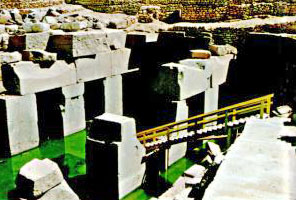 "What was the purpose of this mysterious building
(left)? The fact
that Mer-en-Ptah [13th son of Ramesses II, grandson successor to
Seti-I] decorated the Entrance Passage with scenes and texts
normally found in royal tombs suggests that in his day the building
was apparently regarded as a tomb. The Great Hall itself suggests a
stone sarcophagus, and the rectangular island [in the center of the
Complex, surrounded by nine feet of water ...], the wooden coffin
that it contains. "What was the purpose of this mysterious building
(left)? The fact
that Mer-en-Ptah [13th son of Ramesses II, grandson successor to
Seti-I] decorated the Entrance Passage with scenes and texts
normally found in royal tombs suggests that in his day the building
was apparently regarded as a tomb. The Great Hall itself suggests a
stone sarcophagus, and the rectangular island [in the center of the
Complex, surrounded by nine feet of water ...], the wooden coffin
that it contains.
"Frankfort thought that the island, with its two flights of steps,
was supposed to represent the first hill of dry land that emerged
from the Primeval Ocean at the time of the Creation. He also thought
that the large rectangular and square depressions in the surface of
the island were for a sarcophagus and canopic chest, but they seem
to be much too large for such a purpose ...
"Is it possible that some ruler of the Old Kingdom, thinking that a
mud-brick mastaba tomb was unsuitable for Osiris, rebuilt it in
eternal stone? In some of the ancient hymns Osiris is referred to
as, "He who sleeps surrounded by water." If he were buried on (or in
a still undiscovered chamber, inside) the island, this would
certainly be true ...
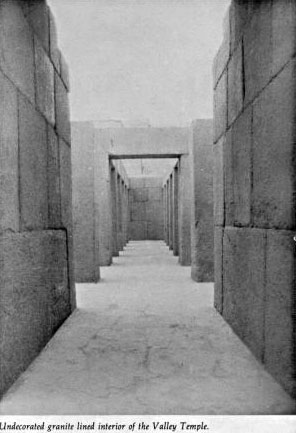 "It would seem as though some Egyptians regarded it [the Osirion] as
the Tomb of Osiris ... But as the channel surrounding the island has
never yet been freed of its water, despite the use of powerful
pumps, and probably never will be, it is unlikely that the mystery
of the Osirion will be solved. It will always remain one of the most
breath-taking puzzles of Egyptology; a challenge for a future
generation of Egyptologists who must really make an exceptional
effort [emphasis added] ..." "It would seem as though some Egyptians regarded it [the Osirion] as
the Tomb of Osiris ... But as the channel surrounding the island has
never yet been freed of its water, despite the use of powerful
pumps, and probably never will be, it is unlikely that the mystery
of the Osirion will be solved. It will always remain one of the most
breath-taking puzzles of Egyptology; a challenge for a future
generation of Egyptologists who must really make an exceptional
effort [emphasis added] ..."
Indeed!
Omm Setyís striking description of "one of the most breath-taking
puzzles of Egyptology íí -- this enigmatic granite structure, long
buried underneath the sands at Abydos -- was obviously heavily
influenced by the widespread thinking of early Egyptologists ...
Because, the same massive granite architecture and "original, stark
simplicity" (in sharp contrast to the profuse adornment seen in
Setiís over-whelming Temple), is also seen in the so-called "Valley
Temple" on the Giza Plateau (right) ... hundreds of miles to the
north!
Which led Omm Sety to conclude:
"... the inner corners of the walls of the halls and chambers [of
the Osirion] are cut in one block of stone thus avoiding a vertical
joint (below, left). This is a characteristic of IVth dynasty
architecture and may also be seen in the Valley Temple of Khafra
(below, right) beside the Great Sphinx of Giza ..."
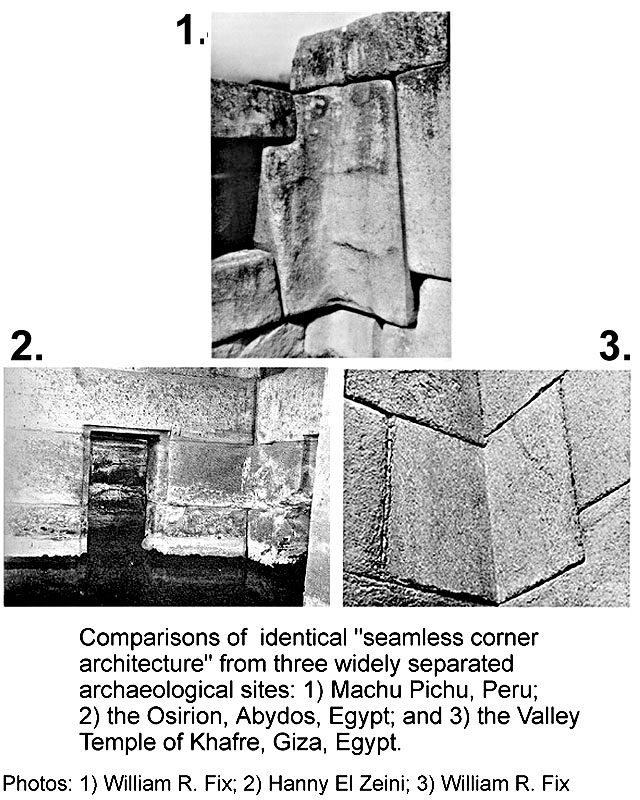
But, though constrained in her thinking by the detailed similarities
of aspects of the Osirion to features seen on the Plateau (which,
all of her contemporaries emphatically know were built by IVth
Dynasty pharaohs and no one else!), Omm Sety still retained enough
observational skills and political independence to note a major
geological discrepancy at Abydos ...
"... [the Osirion] seems much more likely to be a product of the
early IVth dynasty although the [geological] level at which it lies
might tempt one to think of a much earlier date [emphasis added]
..."
Sharp lady!
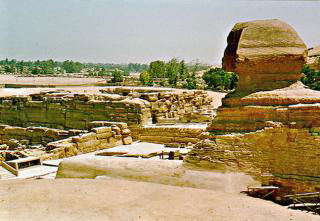 "Rogue" Egyptologist
John Anthony West, and Boston University
geologist Dr. Robert Schoch, leaders in the major redating
controversy of the past few years that has erupted over the creation
of the Sphinx (and its associated granite-lined Temples on the
Plateau -- left), quietly concur; based on the previously
highlighted Abydos architectural and geological evidence, and new
geological data on water erosion from Giza itself (which radically
redates the carving of the Sphinx), both now believe that the Osirion --
hundreds of miles to the south -- could well have been
contemporaneous ... constructed, like the structures at Giza, by a
still-unknown, sophisticated pre-Dynastic civilization ... literally
thousands of years before Egyptís Old Kingdom ... possibly as far
back as 10,500 B.C. "Rogue" Egyptologist
John Anthony West, and Boston University
geologist Dr. Robert Schoch, leaders in the major redating
controversy of the past few years that has erupted over the creation
of the Sphinx (and its associated granite-lined Temples on the
Plateau -- left), quietly concur; based on the previously
highlighted Abydos architectural and geological evidence, and new
geological data on water erosion from Giza itself (which radically
redates the carving of the Sphinx), both now believe that the Osirion --
hundreds of miles to the south -- could well have been
contemporaneous ... constructed, like the structures at Giza, by a
still-unknown, sophisticated pre-Dynastic civilization ... literally
thousands of years before Egyptís Old Kingdom ... possibly as far
back as 10,500 B.C.
And, remember, the architectural style of the Osirion (as Omm Sety
herself noted) shares striking characteristics with much of the
"megalithic" walled architecture visible throughout the continent of
South America (see above comparison with Abydos and Egypt) --
a
quarter of the way around the world from Ancient Egypt!;
architecture currently attributed by archaeologists to "Incan
engineers," but clearly also from a culture now which inexplicably
produced designs for
perfect model airplanes that once flew ..!
(Continued in Part V)
|


 One remarkable "coincidence" about this explanation involves
"Pegasus" -- the well-known Grecian "flying horse" (right), which
got us initially involved with Abydos. For Pegasus (as
a white horse) is also, curiously, closely associated with the theme
of "death" in many other cultures, by way of "a steed who carries
souls to the Beyond ..." He is also strongly associated with water
-- having (in Greek mythology) ostensibly been born of it. (More on
this, below.)
One remarkable "coincidence" about this explanation involves
"Pegasus" -- the well-known Grecian "flying horse" (right), which
got us initially involved with Abydos. For Pegasus (as
a white horse) is also, curiously, closely associated with the theme
of "death" in many other cultures, by way of "a steed who carries
souls to the Beyond ..." He is also strongly associated with water
-- having (in Greek mythology) ostensibly been born of it. (More on
this, below.) 
 It is extraordinary (in terms of our continuing examination of
a
potentially modern "Cult of Osiris," apparently still alive and well
after all these millennia -- and now lurking deep inside NASA ...
just examine the ill-concealed, official NASA "Pegasus" patch for
the ill-fated Apollo13 -- left) that our continuing search,
stretching from the planet Mars ... to Ancient Egypt ... then to
Arizona ... and through Washington itself ... should have ultimately
led us here -- to "Abydos."
It is extraordinary (in terms of our continuing examination of
a
potentially modern "Cult of Osiris," apparently still alive and well
after all these millennia -- and now lurking deep inside NASA ...
just examine the ill-concealed, official NASA "Pegasus" patch for
the ill-fated Apollo13 -- left) that our continuing search,
stretching from the planet Mars ... to Ancient Egypt ... then to
Arizona ... and through Washington itself ... should have ultimately
led us here -- to "Abydos."  Or, so it certainly appeared to one well-known
modern chronicler of Abydos, the legendary "Omm Sety" (right). A remarkable woman in her
own right, a former British subject (originally christened Dorothy Eady), Omm SetyŪs Arabic name (it translates as "Mother of Seti")
was given as a result of her bearing an Egyptian child whom she
deliberately named after "Seti, the First". For Eady, from the age
of four, fervently believed she was in fact the reincarnation of a
former Egyptian priestess in service to Seti-I, part of his Great
Temple retinue who lived at Abydos during the Nineteenth Dynasty,
around 1300 B.C.
Or, so it certainly appeared to one well-known
modern chronicler of Abydos, the legendary "Omm Sety" (right). A remarkable woman in her
own right, a former British subject (originally christened Dorothy Eady), Omm SetyŪs Arabic name (it translates as "Mother of Seti")
was given as a result of her bearing an Egyptian child whom she
deliberately named after "Seti, the First". For Eady, from the age
of four, fervently believed she was in fact the reincarnation of a
former Egyptian priestess in service to Seti-I, part of his Great
Temple retinue who lived at Abydos during the Nineteenth Dynasty,
around 1300 B.C.  Her own written works included a last, co-authored volume on this
fabled "Osirian City of the Dead" (with photographs by Hanny El
Zeini), titled
Her own written works included a last, co-authored volume on this
fabled "Osirian City of the Dead" (with photographs by Hanny El
Zeini), titled
 Omm Setyís Appendix to her book, "the Gods represented in the Temple
of Abydos," describes him thus:
Omm Setyís Appendix to her book, "the Gods represented in the Temple
of Abydos," describes him thus: 


 Egypt. Curiously enough, certain elements of
its architecture closely resemble the íGates of the Suní in
Peru,
high up in the Andes Mountains ...
Egypt. Curiously enough, certain elements of
its architecture closely resemble the íGates of the Suní in
Peru,
high up in the Andes Mountains ... "What was the purpose of this mysterious building
(left)? The fact
that Mer-en-Ptah [13th son of Ramesses II, grandson successor to
Seti-I] decorated the Entrance Passage with scenes and texts
normally found in royal tombs suggests that in his day the building
was apparently regarded as a tomb. The Great Hall itself suggests a
stone sarcophagus, and the rectangular island [in the center of the
Complex, surrounded by nine feet of water ...], the wooden coffin
that it contains.
"What was the purpose of this mysterious building
(left)? The fact
that Mer-en-Ptah [13th son of Ramesses II, grandson successor to
Seti-I] decorated the Entrance Passage with scenes and texts
normally found in royal tombs suggests that in his day the building
was apparently regarded as a tomb. The Great Hall itself suggests a
stone sarcophagus, and the rectangular island [in the center of the
Complex, surrounded by nine feet of water ...], the wooden coffin
that it contains. "It would seem as though some Egyptians regarded it [the Osirion] as
the Tomb of Osiris ... But as the channel surrounding the island has
never yet been freed of its water, despite the use of powerful
pumps, and probably never will be, it is unlikely that the mystery
of the Osirion will be solved. It will always remain one of the most
breath-taking puzzles of Egyptology; a challenge for a future
generation of Egyptologists who must really make an exceptional
effort [emphasis added] ..."
"It would seem as though some Egyptians regarded it [the Osirion] as
the Tomb of Osiris ... But as the channel surrounding the island has
never yet been freed of its water, despite the use of powerful
pumps, and probably never will be, it is unlikely that the mystery
of the Osirion will be solved. It will always remain one of the most
breath-taking puzzles of Egyptology; a challenge for a future
generation of Egyptologists who must really make an exceptional
effort [emphasis added] ..." 
 "Rogue" Egyptologist
John Anthony West, and Boston University
geologist Dr. Robert Schoch, leaders in the major redating
controversy of the past few years that has erupted over the creation
of the Sphinx (and its associated granite-lined Temples on the
Plateau -- left), quietly concur; based on the previously
highlighted Abydos architectural and geological evidence, and new
geological data on water erosion from Giza itself (which radically
redates the carving of the Sphinx), both now believe that the Osirion --
hundreds of miles to the south -- could well have been
contemporaneous ... constructed, like the structures at Giza, by a
still-unknown, sophisticated pre-Dynastic civilization ... literally
thousands of years before Egyptís Old Kingdom ... possibly as far
back as 10,500 B.C.
"Rogue" Egyptologist
John Anthony West, and Boston University
geologist Dr. Robert Schoch, leaders in the major redating
controversy of the past few years that has erupted over the creation
of the Sphinx (and its associated granite-lined Temples on the
Plateau -- left), quietly concur; based on the previously
highlighted Abydos architectural and geological evidence, and new
geological data on water erosion from Giza itself (which radically
redates the carving of the Sphinx), both now believe that the Osirion --
hundreds of miles to the south -- could well have been
contemporaneous ... constructed, like the structures at Giza, by a
still-unknown, sophisticated pre-Dynastic civilization ... literally
thousands of years before Egyptís Old Kingdom ... possibly as far
back as 10,500 B.C.